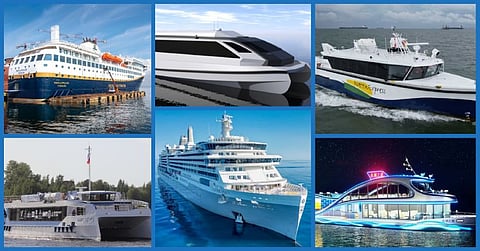

Deliveries include inter-island ferries for the German North Sea, an LNG-fuelled cruise ship for a Monaco-based operator, and two coastal cruise ships for a Norwegian owner. Sea trials begin for a new Russian tour and commuter ferry as construction commences on a sightseeing boat to be operated in south-eastern China. Finally, a Spanish shipbuilder starts development on a new series of low-emission fast ferries.
Fast inter-island ferries delivered to German North Sea operator
German operator Ems Maritime Offshore recently took delivery of three new fast ferries in a series for operation between some of Germany's island communities in the North Sea.
WattnExpress, Inselexpress I, and Watt Sprinter will service three busy routes between the North Frisian Islands and Neuharlingersiel, located on the north coast of Germany's mainland.
The ferries have been tailored to the unique local conditions in the intertidal Wadden Sea zone that separates the German mainland from the North Frisian Islands and the North Sea.
Each vessel has a draught of less than 0.7 metre, making the ferries' operation independent of tidal conditions, which can reach very low levels.
The IMO Tier III-compliant ferries can transport up to 54 passengers at speeds of up to 19 knots. The vessels have also been customised to cater to the local community with space for wheelchair access and large indoor and outdoor luggage storage areas on the main deck.
Silversea Cruises welcomes newest ship to fleet
Monaco-based Silversea Cruises has expanded its fleet with the delivery of the 728-guest ship Silver Nova from German shipyard Meyer Werft.
Measuring 243 by 30 metres, the vessel features numerous restaurants, bars, lounges, and 364 all-balcony guest cabins across 13 categories. The hybrid propulsion system consists of LNG-fuelled main engines and a shore power connection that will shoulder hotel loads in port without having to use the onboard generators.
Silver Nova's inaugural season will include itineraries in the Mediterranean, the Caribbean, and South America.
Norway's Havila Kystruten acquires coastal cruise ship pair
Norwegian operator Havila Kystruten has taken delivery of two coastal cruise ships in a series.
Designed by HAV Ship Design in compliance to DNV rules, Havila Polaris and Havila Pollux are the third and fourth ships in a series to be ordered by the same owner. The first two ships are Havila Capella and Havila Castor, which were delivered in 2021 and 2022, respectively.
The newbuilds each have an LOA of 124.1 metres, a beam of 22 metres, a gross tonnage of 15,471, capacity for 640 passengers, and hybrid LNG and battery propulsion systems. The vessels can sail for up to four hours on battery power alone, while their energy-efficient hull design helps minimise fuel consumption, and therefore further reduces emissions.
Havila Polaris and Havila Pollux will join their earlier sisters on the coastal route between Bergen and Kirkenes.
Sea trials begin for new Russian fast catamaran ferry
Russia's Sredne-Nevsky Shipbuilding Plant has begun conducting sea trials of a new fast catamaran ferry ordered by local customer State Transport Leasing Company (STLC) for operation by Saint Petersburg-based Neva Travel Company.
Like its Project 04580 sister vessels, Fort Pyetr I may be operated as both a commuter ferry and a tourist shuttle. The newbuild boasts all-aluminium construction, an LOA of 32 metres, a beam of 8.7 metres, a draught of 1.32 metres, a depth of 1.4 metres, a speed of 31 knots, and space for three crewmembers and 150 passengers in the main deck cabin and another 50 passengers on the open upper deck.
The ferry is capable of both inland and coastal sailings, as the design is optimised for operation in the waters in and around Saint Petersburg as well as further out into the Gulf of Finland.
Construction starts on Chinese electric sightseeing vessel
Chinese shipbuilder Funing Shipbuilding Industry has begun construction of a sightseeing vessel to be powered entirely by electricity.
Donghu Zhixing ("East Lake Star") was designed by Wuhan Yangtze River Ship Design Institute in compliance to China Classification Society rules. The vessel will be operated by the Ningde Tourism Development Group in the waters off the city of Ningde in Fujian province.
Once completed, the vessel will have an LOA of 26.67 metres, a beam of six metres, and space for 58 passengers. The propulsion system will consist of a 293.9kWh lithium-ion battery pack and two 40kW rudder propellers.
Spanish builder to introduce new catamaran ferry series
Spain's Aresa Shipyard has begun development of a new series of catamaran ferries that can be fitted with either hydrogen fuel cells or all-electric propulsion for use in urban waterways and environmentally sensitive areas.
Each vessel in the series will have a length of 20 metres, a beam of eight metres, a draught of only one metre, space for 120 passengers in an enclosed and air-conditioned deck, electric motors, and a high-capacity battery. The propulsion will generate only minimal vibration even when sailing at speeds of between 15 and 18 knots.
Facilities on each ferry will include a bar, a toilet, a luggage compartment, and an open upper deck. Space will also be available for a small rescue boat.
